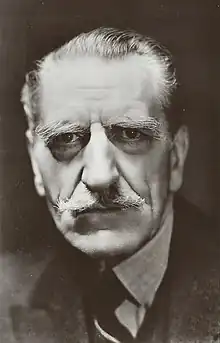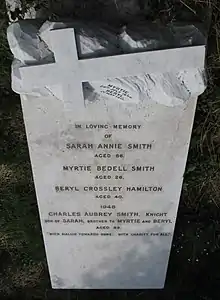C. Aubrey Smith
Sir Charles Aubrey Smith CBE (21 July 1863 – 20 December 1948) was an English Test cricketer who became a stage and film actor, acquiring a niche as the officer-and-gentleman type, as in the first sound version of The Prisoner of Zenda (1937). In Hollywood, he organised British actors into a cricket team, much intriguing local spectators.
 Smith in about 1940 | ||||||||||||||||||||||||||||||||||||||||
| Personal information | ||||||||||||||||||||||||||||||||||||||||
|---|---|---|---|---|---|---|---|---|---|---|---|---|---|---|---|---|---|---|---|---|---|---|---|---|---|---|---|---|---|---|---|---|---|---|---|---|---|---|---|---|
| Full name | Charles Aubrey Smith | |||||||||||||||||||||||||||||||||||||||
| Born | 21 July 1863 London, England | |||||||||||||||||||||||||||||||||||||||
| Died | 20 December 1948 (aged 85) Beverly Hills, California, U.S. | |||||||||||||||||||||||||||||||||||||||
| Batting | Right-handed | |||||||||||||||||||||||||||||||||||||||
| Bowling | Right arm fast | |||||||||||||||||||||||||||||||||||||||
| International information | ||||||||||||||||||||||||||||||||||||||||
| National side | ||||||||||||||||||||||||||||||||||||||||
| Only Test (cap 66) | 12 March 1889 v South Africa | |||||||||||||||||||||||||||||||||||||||
| Domestic team information | ||||||||||||||||||||||||||||||||||||||||
| Years | Team | |||||||||||||||||||||||||||||||||||||||
| 1882–1896 | Sussex | |||||||||||||||||||||||||||||||||||||||
| 1882–1885 | Cambridge University | |||||||||||||||||||||||||||||||||||||||
| 1889/90 | Transvaal | |||||||||||||||||||||||||||||||||||||||
| Career statistics | ||||||||||||||||||||||||||||||||||||||||
| ||||||||||||||||||||||||||||||||||||||||
Source: CricketArchive, 23 September 2008 | ||||||||||||||||||||||||||||||||||||||||
Early life
Smith was born in London, England, to Charles John Smith (1838–1928), a medical doctor, and Sarah Ann (née Clode, 1836–1922).[1][2] His sister, Beryl Faber (died 1912), was married to Cosmo Hamilton.
Smith was educated at Charterhouse School and St John's College, Cambridge.[3][4] He settled in South Africa to prospect for gold in 1888–89. While there he developed pneumonia and was wrongly pronounced dead by doctors. He married Isabella Wood in 1896.
Cricket career

As a cricketer, Smith was primarily a right arm fast bowler, though he was also a useful right-hand lower-order batsman and a good slip fielder. His oddly curved bowling run-up, which started from deep mid-off, earned him the nickname "Round the Corner Smith".[5][6] When he bowled round the wicket his approach was concealed from the batsman by the umpire until he emerged, leading W. G. Grace to comment "it is rather startling when he suddenly appears at the bowling crease."[7] He played for Cambridge University (1882–1885) and for Sussex at various times from 1882 to 1892.[3]
While in South Africa he captained the Johannesburg English XI.[3] He captained England to victory in his only Test match,[5] against South Africa at Port Elizabeth in 1888–89, taking five wickets for nineteen runs in the first innings.[8] The English team who played were by no means representative of the best players of the time and nobody at the time realised that the match would enter the cricket records as an official Test match. His home club for much of his career was West Drayton Cricket club. Actors would arrive from London to the purpose-built train station in West Drayton and taken by horse-drawn carriage to the ground.
In 1932, he founded the Hollywood Cricket Club and created a pitch with imported English grass. He attracted fellow expatriates such as David Niven, Laurence Olivier, Nigel Bruce (who served as captain), Leslie Howard[9] and Boris Karloff to the club as well as local American players. Smith's stereotypical Englishness spawned several amusing anecdotes: while fielding at slip for the Hollywood Club, he dropped a difficult catch and ordered his English butler to fetch his spectacles; they were brought on to the field on a silver platter. The next ball looped gently to slip, to present the kind of catch that "a child would take at midnight with no moon." Smith dropped it and, snatching off his lenses, commented, "Damned fool brought my reading glasses."[10] Decades after his cricket career had ended, when he had long been a famous face in films, Smith was spotted in the pavilion on a visit to Lord's. "That man over there seems familiar", remarked one member to another. "Yes", said the second, seemingly oblivious to his Hollywood fame, "Chap called Smith. Used to play for Sussex."[11]
Acting career
.jpg.webp)


Smith began acting on the London stage in 1895. His first major role was in Prisoner of Zenda the following year, playing the dual lead roles of king and look-alike. Forty-one years later, he appeared in the most acclaimed film version of the novel, this time as the wise old adviser. When Raymond Massey asked him to help him understand the role of Black Michael, he answered "My dear Ray, in my time I have played every part in The Prisoner of Zenda except Princess Flavia. And I always had trouble with Black Michael!"[12] He made his Broadway debut as early as 1895 in The Notorious Mrs. Ebbsmith. In 1907 he appeared with Marie Doro in The Morals of Marcus, a play Doro later made into a silent film. Smith later appeared in a revival of George Bernard Shaw's Pygmalion in the starring role of Henry Higgins.
Smith appeared in early films for the nascent British film industry, starring in The Bump in 1920 (written by A. A. Milne for the company Minerva Films, which was founded in 1920 by the actor Leslie Howard and his friend and story editor Adrian Brunel).[13] Smith later went to Hollywood where he had a successful career as a character actor playing either officer or gentleman roles. One role in 1937 was as Colonel Williams in Wee Willie Winkie, starring Shirley Temple, Victor McLaglen, Cesar Romero and June Lang. He was regarded as being the unofficial leader of the British film industry colony in Hollywood, which Sheridan Morley characterised as the Hollywood Raj,[14] a select group of British actors who were seen to be colonising the capital of the film business in the 1930s. Other film stars considered to be "members" of this select group were David Niven (whom Smith treated like a son), Ronald Colman, Rex Harrison, Robert Coote, Basil Rathbone, Nigel Bruce (whose daughter's wedding he had attended as best man), Leslie Howard (whom Smith had known since working with him on early films in London),[15] and Patric Knowles.
Smith expected his fellow countrymen to report for regular duty at his Hollywood Cricket Club. Anyone who refused was known to "incur his displeasure". Fiercely patriotic, Smith became openly critical of the British actors of enlistment age who did not return to fight after the outbreak of World War II in 1939. Smith loved playing on his status as Hollywood's "Englishman in Residence". His bushy eyebrows, beady eyes, handlebar moustache, and height of 6'2" made him one of the most recognisable faces in Hollywood.
Smith starred alongside leading ladies such as Greta Garbo, Elizabeth Taylor, and Vivien Leigh as well as the actors Clark Gable, Laurence Olivier, Ronald Colman, Maurice Chevalier, and Gary Cooper. His films include The Prisoner of Zenda (1937), The Four Feathers (1939), Hitchcock's Rebecca (1940), Dr. Jekyll and Mr. Hyde (1941), And Then There Were None (1945) in which he played General Mandrake, and the 1949 remake of Little Women starring Elizabeth Taylor and Janet Leigh, in which he portrayed the aged grandfather of Laurie Lawrence (played by a young Peter Lawford), who generously gives a piano to the frail Beth March (played by Margaret O'Brien). He also appeared as the father of Maureen O'Sullivan in Tarzan the Ape Man, the first Tarzan film with Johnny Weissmüller. Smith also played a leading role as the Earl of Dorincourt in David O. Selznick's adaption Little Lord Fauntleroy (1936).
He appeared in Dennis Wheatley's 1934 thriller Such Power Is Dangerous, about an attempt to take over Hollywood, under the fictitious name of Warren Hastings Rook (rather than Charles Aubrey Smith). Author Evelyn Waugh leaned heavily on Smith in drawing the character of Sir Ambrose Abercrombie for Waugh's 1948 satire of Hollywood The Loved One. Commander McBragg in the TV cartoon Tennessee Tuxedo and His Tales is a parody of him.
Death
Smith died of pneumonia at home in Beverly Hills on 20 December 1948, aged 85. He was survived by his wife and their daughter, Honor.[16] His body was cremated and nine months later, in accordance with his instructions, the ashes were returned to England and interred in his mother's grave at St Leonard's churchyard in Hove, Sussex.
Honours and awards
Smith has a star on the Hollywood Walk of Fame.[17]
Smith was an officer in the Legion of Frontiersmen.
In 1933, he served on the first board of the Screen Actors Guild.
He was appointed a Commander of the Order of the British Empire (CBE) in 1938[18] and was knighted by George VI in 1944[19] for services to Anglo-American amity.[20][21][22]
Complete filmography
References
- "Smith, Sir (Charles) Aubrey (1863–1948)". Oxford Dictionary of National Biography (online ed.). Oxford University Press. doi:10.1093/ref:odnb/56993. (Subscription or UK public library membership required.)
- Who Was Who in the Theatre: 1912–1976 vol. 4, Q-Z, p. 2208; compiled from editions originally published annually by John Parker, this 1976 version by Gale Research.
- Wills, Walter H., 1907. The Anglo-African Who's Who, Jeppestown Press, United Kingdom. p. 337. ISBN 0-9553936-3-9
- "Smith, Charles Aubrey (SMT881CA)". A Cambridge Alumni Database. University of Cambridge.
- Frindall, Bill (2009). Ask Bearders. BBC Books. p. 46. ISBN 978-1-84607-880-4.
- "The Greatest: One Test Wonders". International Cricket Council. Retrieved 19 April 2018.
- Sir Aubrey Smith. Content-uk.cricinfo.com. Retrieved on 19 May 2018.
- South Africa v England at Port Elizabeth, 1889. Content-uk.cricinfo.com. Retrieved on 19 May 2018.
- Eforgan, E. (2010) Leslie Howard: The Lost Actor. London: Vallentine Mitchell; p. 94, ISBN 978-0-85303-971-6.
- Jones, Grahame L (7 October 1989). "Howzat? It's Cricket: Popular From Karachi to Kingston, the Sport Is Also Alive and Well in the Southland". Los Angeles Times. Retrieved 15 August 2012.
- Lynch, Steven (28 February 2005). "The cricketer who died on the Titanic". Cricinfo Magazine. ESPN. Retrieved 15 August 2012.
- Fairbanks, Douglas (1988). Salad Days (First ed.). New York: Doubleday. p. 275. ISBN 0-385-17404-7.
- Eforgan, E. (2010) Leslie Howard: The Lost Actor. London: Vallentine Mitchell; chapter 3. ISBN 978-0-85303-971-6.
- Sheridan Morley: The Brits in Hollywood: Tales from the Hollywood Raj (UK: Weidenfeld & Nicolson, 1983) ISBN 0-297-78289-4, also published as Tales From The Hollywood Raj: The British, the Movies, and Tinseltown (New York: Viking, 1983), ISBN 0-670-69162-3.
- Eforgan, E. (2010) Leslie Howard: The Lost Actor London: Vallentine Mitchell; chapter 5. ISBN 978-0-85303-971-6.
- "The Final Curtain". Billboard. 1 January 1949. Retrieved 23 September 2018.
- C. Aubrey Smith – Awards. IMDb
- Commanders of the Order of the British Empire – Supplement to The London Gazette, 9 June 1938, p. 3701.
- Recipients of the Honour of Knighthood – Supplement to The London Gazette, 2 June 1944, p. 2566.
- C. Aubrey Smith – Biography. IMDb
- The Home of CricketArchive. Cricketarchive.com (20 December 1948). Retrieved on 2018-05-19.
- Obituary Variety, 22 December 1948, p. 55.
- "Silent Preservation Premieres: The Unwanted (1924) & A Hundred Years Ago – French shorts". Cinemamuseum.org.uk (8 September 2011). Retrieved on 2018-05-19.
- Directors: René Clair, Edmund Goulding, Cedric Hardwicke, Frank Lloyd, Victor Saville, Robert Stevenson and Herbert Wilcox.
Further reading
- David Rayvern Allen, Sir Aubrey: Biography of C. Aubrey Smith, England Cricketer, West End Actor, Hollywood Film Star, Elm Tree Books, 1982, ISBN 978-0-241-10590-0